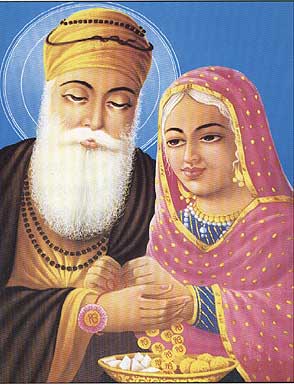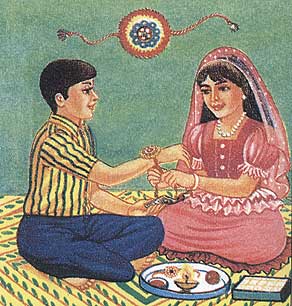
Bebe Nanaki sister of Guru Nanak tying rakhri to her brother
Sravani,
the sacred thread changing ceremony, and Raksha Bandhan are celebrated on the
full moon day of the month of Shravan (June-July) and are often regarded as two
names for the same festival. This is not strictly true because Sravani is a specifically
Brahmin festival referred to in the sacred Sanskrit texts as Rishi Tarpan or Upa
Karma. It is a very ancient Vedic festival and even today is regarded as important
in Bengal, Orissa, southern India, Gujarat and some other states. The more popular
of the two festivals, however, is Raksha Bandhan.
We do not have any reliable
evidence on when, why or where Raksha Bandhan came into vogue. There is, however,
a well-known tale in the Puranas about a fierce battle that raged between the
gods and demons. From news received from the battlefield it appeared that the
demons were getting the upper hand and would gain victory.
Indra, the supreme
deity, summoned his teacher Vrihaspati to his court for advice. Indra's wife Indrani
was also present. Before the teacher could speak, Indrani rose and said, "I
know how to assure the victory of the gods. I give you my word that we will win."
The
next day was the full moon night of the month of Shravan. Indrani had a charm
prepared as prescribed by the sacred texts and tied it on the wrist of her husband.
And no sooner did Indra appear on the battlefield with the charm onhis hand than
the demons scattered and fled. The demons bit the dust and the gods were victorious.
It
would appear that the Raksha Bandhan of today is derived from this belief. It
is held that if a chord made according to the prescriptions of the holy texts
is tied round the wrist of a person on the full moon day of Shravan it will ensure
him good health, success and happiness for the year that follows.
Whatever
be the origin of Raksha Bandhan, today it has come to be a kind of sisters' day,
symbolising the love that binds them to their brothers.No matter where a brother
may be, be he across the seven seas, on this day he must wear the coloured chord
round his wrist. You can realise the sanctity of this custom from the fact that,
even if a girl who is a total stranger ties this chord on the wrist of a young
man, from then on the two regard each other as brother and sister and consider
themselves closer than other blood relations.
Many days before the festival,
stalls are set up at different places, packed with colourful and glittering masses
of Raksha Bandhan wristlets. In some smaller towns, whole rows of bazaars sell
nothing but these rakhis of all shapes and hues—red, yellow, pink, green,
blue, trimmed with silver and gold thread. At these stalls one can see throngs
of women of all ages, ranging from tiny tots to middle-aged matrons, who come
for their rakhi shopping dressed in their best fineries, as colourful as the rakhis
they buy. Rakhi prices vary from five paise for a coloured string to a gaudy silver-and-gold
laced affair worth five rupees.
At the same time, sweetmeat vendors do a roaring
trade. They put out all their delicacies on display—laddoos, jalebis, barfi,
balushahi, imarti, gulab jamuns, rasgullas and cham-cham—the more you gaze
at them, the more yourmouth will water. You forget all the doctor's warnings that
eating sweets is bad for the teeth and digestion; these sweets are a must for
Raksha Bandhan.
When the great day dawns (the full moon night of July-August),
the girls' excitement has to be seen to be believed. On other days they may sleep
late but on Raksha Bandhan they are up before dawn. After a quick bath, they get
into their best clothes. By then their brothers are also bathed and dressed. Then
the girls take the rakhi still attached to its strip of cardboard and put it on
top of a thali full of sweets. Covering her head with her dupatta, the sister
seats herself in front of her brother, daubs his forehead with vermillion, saffron
and rice powder, takes the colourful rakhi and ties it to his wrist. She will
then take a piece of some sweetmeat and playfully stuff it in her brother's mouth.
He, in his turn, as a mark of his affection, places some money on the thali—it
may be anything upward of a rupee. Till the girls have tied the chord on their
brothers' wrists neither will break their fast. All that day, till the evening,
the brother will keep the rakhi on his wrist. It is also customary to fry poories
and cook vermicelli pudding on this occasion.

When
a girl ties a rakhi on her brother's wrist, she makes fervent wishes for his prosperity,
happiness and success in all he undertakes. In return, he renews his pledge to
guard her honour and self-respect with the last drop of his blood.
On
Raksha Bandhan day, Brahmins and priests also tie rakhis round the wrists of their
patrons and in return receive offerings from them. In some parts of the country,
it is customary to draw figures on house walls and worship them with offerings
of vermillion or kheer. The imprints of palms are also put on either side of the
entrance and rakhis are stuck on them.
In India the same festival is celebrated
in slightly differentforms in different areas. This is also true of Raksha Bandhan
which is known by a variety of names—Rakhi, Rakhri, Saluno. Although at Raksha
Bandhan there is no display of fireworks, no beating of drums, or decorating of
homes with coloured lights, this festival has an importance of its own. The gift
of money that brothers give when their sisters tie the rakhi on their wrist may
appear trivial at first sight but it means more to the girls than all the wealth
of the world. There are many instances in our history when the real worth of these
seemingly worthless pieces of string was demonstrated in the field of battle.
The most famous of these incidents is the tale of Maharani Karmvati (or Karunavati).
It is said that once Governor Bahadur Shah besieged her kingdom. When Karmvati
saw the countless horde led by Bahadur Shah, she lost heart. Then suddenly she
thought of Emperor Humayun. She sent him a rakhi. Normally Emperor Humayun would
not have gone to the aid of a Hindu Maharani fighting Bahadur Shah. But so strong
was the tradition of rakhi that Emperor Humayun immediately proceeded to Mewar.
By the time he got there, however, the Maharani had immolated herself on a funeral
pyre. The Emperor was grief-stricken. But he pursued Bahadur Shah, caught up with
him, and routed his army. In the annals of the Mughals, there are many instances
of Mughal emperors accepting rakhi bands from Hindu women and pledging to respect
their honour. The history of Rajasthan is replete with examples of sacrifices
of life made by men to protect the honour of women who had tied rakhis on their
wrists. During the freedom movement, many women tied rakhis on men's wrists and
made them pledge their lives to the struggle for India's liberation. It was probably
for this reason that the great leader of Bengal, Surendranath Banerjee, tried
to elevate Raksha Bandhan to the status of a national festival.Women who have
no brothers, or men who have no sisters deserve our sympathy. If God were to ask
them for a wish, without doubt, instead of asking for good luck or prosperity,
a woman would ask for a brother and a man for a sister.
Original Hindi: Prithviraj
Monga (Courtesy 'Festivals of India)
Another historical incident
is recorded in the history of Alexander the Great, when he invaded Punjab. The
King of Punjab at the time Porus was a very pious and brave king with whom Alexander
had to do battle. Alexander's fiancee tied a rakhri on Porus's hand and asked
for him to spare him (Alexander) during the ensuing battle. In the battle Alexander
at one time was at the mercy of Porus but the King spared Alexander's life but
this cost him the battle. When Porus was brought in front of Alexander, he asked
Porus how should he be treated, and the immortal words which King Porus uttered
were, 'As a King treats a King.' Alexander was very impressed with this
and gave Porus back his kingdom. (Kanwal)
FOR SENDING GREETING CARDS ON THE OCCASION CONTACT;-
